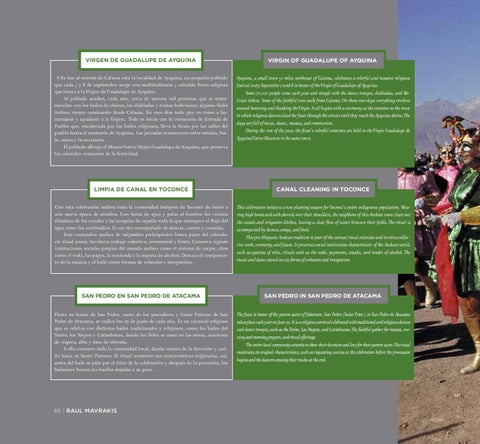VIRGEN DE GUADALUPE DE AYQUINA
VIRGIN OF GUADALUPE OF AYQUINA
A 80 km al noreste de Calama está la localidad de Ayquina, un pequeño poblado que cada 7 y 8 de septiembre acoge una multitudinaria y colorida fiesta religiosa que honra a la Virgen de Guadalupe de Ayquina. Al poblado acuden, cada año, cerca de setenta mil personas que se entremezclan con los bailes de chinos, las diabladas y tinkus bolivianos; algunos fieles incluso vienen caminando desde Calama. En esos días todo gira en torno a homenajear y agradecer a la Virgen. Todo se inicia con la ceremonia de Entrada de Pueblo que, encabezada por los bailes religiosos, lleva la fiesta por las calles del pueblo hasta el santuario de Ayquina. Las jornadas transcurren entre música, baile, misas y la eucaristía. El poblado alberga el Museo Votivo Virgen Guadalupe de Ayquina, que preserva los coloridos vestuarios de la festividad.
Ayquina, a small town 50 miles northeast of Calama, celebrates a colorful and massive religious festival every September 7 and 8 in honor of the Virgin of Guadalupe of Ayquina. Some 70,000 people come each year and mingle with the dance troupes, diabladas, and Bolivian tinkus. Some of the faithful even walk from Calama. On those two days everything revolves around honoring and thanking the Virgin. It all begins with a ceremony at the entrance to the town in which religious dancers lead the feast through the streets until they reach the Ayquina shrine. The days are full of music, dance, masses, and communion. During the rest of the year, the feast’s colorful costumes are held in the Virgin Guadalupe de Ayquina Votive Museum in the same town.
LIMPIA DE CANAL EN TOCONCE
CANAL CLEANING IN TOCONCE
Con esta celebración andina toda la comunidad indígena de Toconce da inicio a una nueva época de siembra. Con botas de agua y palas al hombro los vecinos eliminan de los canales y las acequias de regadío todo lo que entorpece el flujo del agua entre los sembradíos. Es un rito acompañado de danzas, cantos y comidas. Esta costumbre andina de raigambre prehispánica forma parte del calendario ritual anual. Involucra trabajo colectivo, ceremonial y fiesta. Conserva vigente instituciones sociales propias del mundo andino como el sistema de cargos, ritos como el waki, los pagos, la merienda y la ingesta de alcohol. Destaca el componente de la música y el baile como formas de cohesión e integración.
This celebration initiates a new planting season for Toconce’s entire indigenous population. Wearing high boots and with shovels over their shoulders, the neighbors of this Andean town clean out the canals and irrigation ditches, leaving a clear flow of water between their fields. The ritual is accompanied by dances, songs, and food. This pre-Hispanic Andean tradition is part of the annual ritual calendar and involves collective work, ceremony, and feasts. It preserves social institutions characteristic of the Andean world, such as systems of roles, rituals such as the waki, payments, snacks, and intake of alcohol. The music and dance stand out as forms of cohesion and integration.
SAN PEDRO EN SAN PEDRO DE ATACAMA
SAN PEDRO IN SAN PEDRO DE ATACAMA
Fiesta en honor de San Pedro, santo de los pescadores y Santo Patrono de San Pedro de Atacama, se realiza los 29 de junio de cada año. Es un carnaval religioso que se celebra con distintos bailes tradicionales y religiosos, como los bailes del Torito, los Negros y Catimbanos, donde los fieles se unen en las misas, oraciones de víspera, alba y ritos de ofrenda. A ella concurre toda la comunidad local, dando cuenta de la devoción y cariño hacia su Santo Patrono. El ritual mantiene sus características originarias, así, antes del baile se pide por el éxito de la celebración y después de la procesión, los bailarines borran las huellas dejadas a su paso.
The feast in honor of the patron saint of fishermen, San Pedro (Saint Peter), in San Pedro de Atacama takes place each year on June 29. It is a religious carnival celebrated with traditional and religious dances and dance troupes, such as the Torito, Los Negros, and Catimbanos. The faithful gather for masses, evening and morning prayers, and ritual offerings. The entire local community attends to show their devotion and love for their patron saint. The ritual maintains its original characteristics, such as requesting success in the celebration before the procession begins and the dancers erasing their tracks at the end.
46 | RAUL MAVRAKIS
